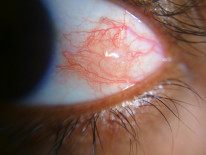Episcleritis is benign and self-limiting, compared to scleritis, which can be severe and sight-threatening. They can be differentiated clinically and are commonly examined.
Episcleritis
A benign inflammatory condition which typically recurs but is often self-limiting.
Pathology
- Not classically associated with systemic disease.
- Inflammation of the episclera is relatively benign.
Diagnostics

Presentation
- Sudden onset eye ache, tearing and photophobia.
- The eye is sectorally red and non-tender.
Investigations
- The red parts of the eye blanch with the administration of topical vasoconstrictors such as phenylephrine 10%.
Management
- Conservative management with topical lubricants and NSAIDs for symptom control is sufficient.
- Episcleritis typically self-resolves within 2 weeks.
Scleritis
Scleritis is uncommon and potentially blinding. It is typically classified as anterior or posterior scleritis, depending on which part of the sclera is affected. Unlike episcleritis, scleritis is often associated with systemic diseases.
Pathology
- There are a few different classifications of scleritis, based on location, nodularity, necrosis and inflammation.
- Anterior diffuse scleritis is the most common type.
- Rheumatoid arthritis is the commonest systemic association.
Diagnostics
Presentation
- Severe deep boring eye pain that keeps the patient awake.
- Tender globe.
- Diffusely red eye.
Investigation
- Red-eye does not blanch with topical administration of phenylephrine.
If a question mentions red-eye and phenylephrine, it is driving towards scleritis or episcleritis.
Management
Scleritis needs systemic anti-inflammatory treatment. The strength of treatment is determined by clinical severity. Topical steroids can be used to aid symptoms in the overall management plan but will not be enough to treat the disease:
- Oral NSAIDs
- Oral steroids
- IV steroids
The general treatment approach is based on initial high-dose rescue therapy followed by tapering treatment.

